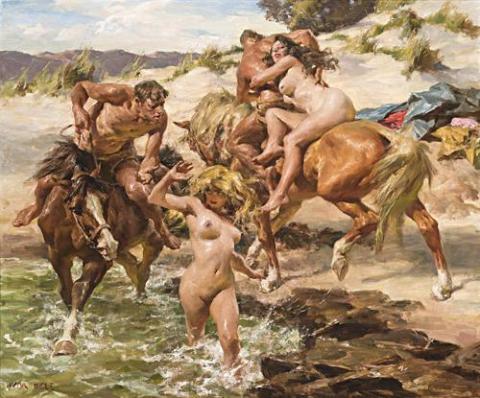THE PICK UP, 1982
Ivor Hele
oil on composition board
76.0 x 91.0 cm
signed lower left: IVOR HELE
Rider on the Beach, 1953, oil on board, 30.5 x 20.3 cm, Art Gallery of South Australia
Horse and Rider with Family in Surf , 1970s, oil on board, 66.0 x 51.0 cm, private collection
The Pick Up had its origins at Maslin Beach in South Australia where Ivor Hele and his first wife Jean used to enjoy swimming in the nude, long before it became fashionable. Bronzed of body, muscular, and of robust good health, he enjoyed surfing and the open air, features that distinguish his many subject paintings. Moreover, he was not only handsome and of attractive personality, but also possessed enormous talent and abundant energy, his works abounding in these qualities. Jane Hylton, in her book on Hele wrote that he had been inspired by the beach and its physical attractions from when he settled at Aldinga in 1937. Here 'he indulged his passionate love of animals, especially horses, and his love of the human figure, and these were frequently combined in energetic images of nude figures on horseback and in surf, such as his painting of 1953, Rider on the beach.' Seeing local farm horses exercising at Maslin Beach 'sank into his memory, ready to emerge years later.'1
When an artist achieves fame in one area it often overshadows success in another. Hele was one of Australia's most popular and successful portrait painters. In addition to painting over three hundred portraits of the great and powerful, he won the Archibald Prize five times. Winning portraits included those of Prime Minister R. G. Menzies, arts writers and gallery directors Laurie Thomas and Robert Campbell, and a self-portrait which won the 1957 award. Although he had early successes as a gifted subject painter - in 1936 he won the South Australian Centenary Art Prize for the history painting, The Reading of the Proclamation and the 1938 Sesquicentenary Commonwealth Art Prize for Sturt's Reluctant Decision to Return - it was not until his rare solo show during the 1970 Adelaide Festival that the public was given the opportunity to see the full range of his talents, especially as a painter of richly peopled subject pictures.
While The Pick Up is outside the range of history, it does evoke thoughts of classical mythology, of a golden age of mythic nymphs and centaurs transported to the clear skies and yellow sands of the antipodes, peopled by those of fine physique reflecting that of his own. Such classical references are not unknown in Hele's art, early examples beingCharon, c.1927 and Silenius, c1930. In later years his subjects ranged from the ballet to the brothel with ladies of Rubenesque endowment, his last painting being a rollicking circus scene. The Pick Up brings together a number of Hele's interests - his love of horses and the human figure, a sense of drama, and boundless energy.
1. Hylton, Jane, Ivor Hele: the productive artist, Wakefield Press, Adelaide, 2002, pp. 31-32
DAVID THOMAS
